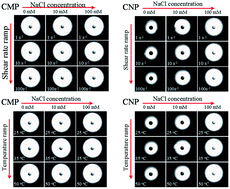The aggregation behavior of cellulose micro/nanoparticles in aqueous media
Abstract
Cellulose microparticles (CMPs) and cellulose nanoparticles (CNPs) were obtained from cotton microcrystalline cellulose (MCC) using a NaOH/urea system and sulfuric acid hydrolysis, respectively. The comparative analysis of the morphology and surface charge density between the CMP and CNP is carried out. Moreover, the effect of ionic strength on the aggregation behavior of the CMP and CNP in aqueous media has been investigated by means of small-angle light scattering during rheological characterization (rheo-SALS). The aqueous CMP suspensions present more pronounced particle aggregation than the CNP suspensions at the same concentration. Moreover, the dimensions of the CNP aggregates can be tuned by changing ionic strength, while the CMP aggregates are stable and do not reorganize themselves with ionic strength. Both the aqueous CMP and CNP suspensions exhibit a shear-thinning behavior, and the SALS patterns indicate the aqueous suspensions remain isotropic with no preferential alignment in the shear direction. With the addition of NaCl, the viscosity of CNP increases significantly over the shear rate range investigated, while that of CMP is less sensitive. The different responsive behavior to the addition of NaCl between the two types of suspensions is ascribed to the difference in the amount of surface charge, which governs the interparticle forces.


 Please wait while we load your content...
Please wait while we load your content...